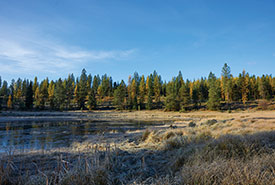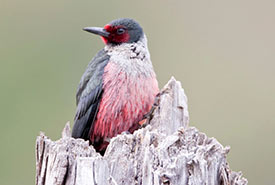Restoring balance

Kootenay River Ranch Conservation Area, BC (Photo by Colin Way)
The work of ecosystem restoration is critical to species at risk recovery, the fight against biodiversity loss and maintaining the benefits and services that nature provides for people.
By Niki Wilson, journalist and science communicator
It’s early summer here in the Upper Columbia River Valley, British Columbia, and as we stroll out into the Kootenay River Ranch Conservation Area, we’re greeted with a loud peep. Then another. And another. Here among the sparse Ponderosa pines and dry grass, Columbian ground squirrels signal each other from the mouths of dusty burrows that dot this open forest. A few metres away, two of them scamper down what remains of an old, sandy road. “Badger food,” says Kate MacKenzie, standing near me, as she watches them dive for cover. MacKenzie is a stewardship coordinator for the Nature Conservancy of Canada (NCC). Columbian ground squirrels are a favourite menu item for American badger, a species listed as endangered under Canada’s Species at Risk Act. Returning badgers to the landscape is one of the conservation goals on this property, she says, but it’s not the only one. Since NCC began to secure land in this part of the Rocky Mountain Trench in 2004, staff have worked to thin dense forests to bring back the open forest and grassland savannah that were here before Europeans arrived. Badgers like it, but so do a host of other pecies at risk, including threatened Lewis’s woodpeckers that nest in the abandoned cavities of old tree snags.

Lewis's woodpecker (Photo by iStock)
MacKenzie is one of hundreds of staff who tend to similar restoration projects across the country. Ecosystem restoration is a core activity for NCC. Staff collaborate with volunteers to plant trees and grasses, control erosion, remove non-native species, clear streams from obstruction and help stabilize shorelines. Restoration is also so central to the health of global ecosystems that the United Nations has declared the next 10 years (2021–2030) the Decade on Ecosystem Restoration. This initiative aims to recognize the importance of restoration in preventing, halting and reversing the degradation of ecosystems worldwide. NCC hopes to play a pivotal role in amplifying and implementing the UN’s goals in Canada. NCC already has many boots on the ground — a history of “putting money together and actually getting things done,” says restoration ecologist Stephen Murphy at the University of Waterloo. NCC has also avoided a common pitfall of restoration efforts that occur when those undertaking a project are not explicit about what they are trying to achieve, he says. “They are very clear and realistic,” he says about NCC’s goals.
One of those goals is creating functioning ecosystems, and that includes bringing back the processes that shape them, says Dan Kraus, NCC’s former national conservation biologist. “In places like Manitoba’s tall grass region, it’s about restoring the flow of water,” he explains. In other places, like the Kootenay River Ranch Conservation Area, it’s about intentionally bringing back fire. Now that tree thinning has opened up the forest there, MacKenzie and her colleagues are planning a prescribed burn for next year, similar to the way that frequent wildfires occurred on the landscape. This maintains the dry open forests and grasslands that wildlife and Indigenous Peoples relied on for millennia.
NCC has already used prescribed burns to help restore tall grass prairie and oak savannah in the Rice Lake Plains Natural Area in Ontario. “It is quite dramatic how it changes the landscape,” says Kraus. This area has been badly fragmented and overgrown with non-native species. Combined with thinning and hand-pulling, prescribed burns have removed young trees and shrubs without harming the mature ones. Fire has also prepared the soil for native grasses and flowers to grow. “In some cases, the seeds have been laying there for decades, waiting for the return of this natural process,” says Kraus. On some restored sites, Kraus has stood in a field of native grasses punctuated by old black oak trees and imagined, “this is what it looked like over a hundred years ago.” Many species at risk live here, such as eastern hog-nosed snake, eastern meadowlark and monarch.
While ecosystem restoration is critical to species at risk recovery and the efforts to halt biodiversity loss, more generally, it’s also critical for maintaining the benefits and services that nature provides for people. Intact ecosystems are more resilient to climate change, provide critical habitat for many species that pollinate crops and are important for human mental and physical health. Wetland restoration on Pelee Island, in Ontario, is an example of a project that is checking many of those boxes, says Kraus. Not only is it creating a place for people to go birdwatching, but it is also a system that provides important water retention, filtration and flood mitigation for the local community.
This is an excerpt of a story that first appeared in the fall 2021 issue of the Nature Conservancy of Canada Magazine. Donors who contribute at least $25 or more per year will receive the magazine. Click here to donate today and start receiving the magazine.
Explore additional content from our fall issue here >




